Where is Bolivia?
About Bolivia
The Land
The People
Life and Death
Health, Energy and the Environment
Education and Work
Travel, Communication and the Media






Back to the Flags of South America page




Bolivia is a vast country in the central west of South America.
Bolivia is a landlocked country with no coastline.
The land has the high Andes Mountains in the west and the lowland plains of the Amazon basin in the east.
The geographical coordinates for the centre of Bolivia, also known as lines of latitude and longtitude, are:-
Latitude - 17 00S
Longitude - 65 00W
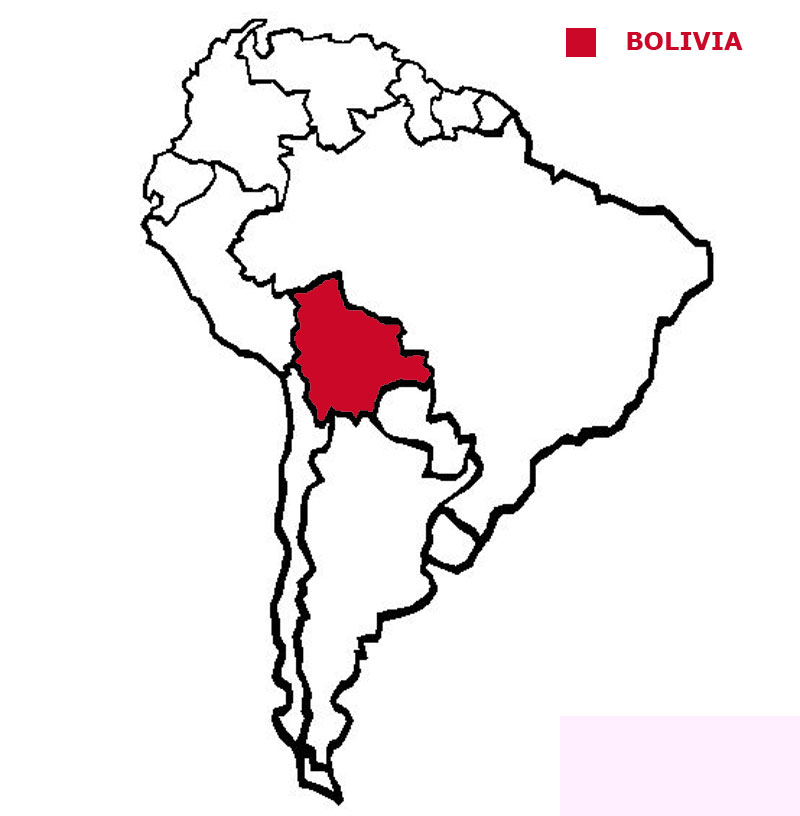

Check the weather in Sucre now.
This is the time in Sucre now
 The Bolivian flag is 3 equal horizontal
stripes of red, yellow and green. The coat of arms is in the centre of the yellow stripe.
The Bolivian flag is 3 equal horizontal
stripes of red, yellow and green. The coat of arms is in the centre of the yellow stripe.
Bolivia is a presidential republic with a president as head of state and head of government.
In elections everyone over the age of 18 must vote.
The currency in Bolivia is the boliviano.
Spanish, Quechua, Aymara and Guarani (the last 3 being native languages) are the official languages.
Hear the National Anthem
These are the anthem words
We have already written our own history of England but are asking schools in Bolivia to provide us with a detailed history of
their own country. Check how here.
![]()
![]() Back to the top
Back to the top

The total land area of Bolivia is 1,083,301 sq kms which is the 4th largest in South America.
Bolivia has lakes, rivers and canals which total 15,280 sq kms.
Bolivia has boundaries with 5 countries
- Brazil 3,403 kms
- Peru 1,212 kms
- Argentina 942 kms
- Chile 942 kms
- Paraguay 753 kms
Bolivia has no coastline.
The highest point in Bolivia is Nevado Sajama at 6,542 metres.
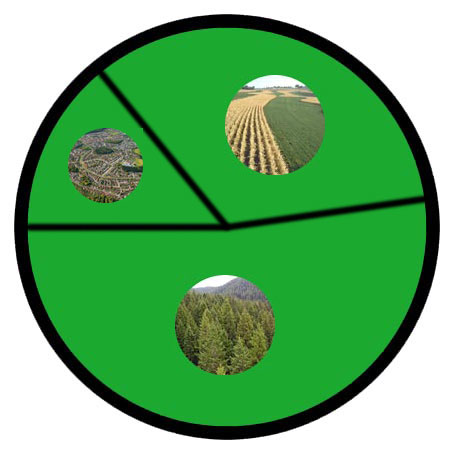

The total population of Bolivia is 10.97 million people, making it the 8th largest country in South America by population.
Of this number 5.54 million are females and 5.43 million are males.
A person from Bolivia is called a Bolivian.
To be a citizen of Bolivia you must be born in Bolivia or one of your parents must be a citizen of Bolivia. You have to live in Bolivia for
3 years before you can begin to apply for citizenship.
The largest five cities in Bolivia, by population are:-
- Santa Cruz 1,364,389 people
- Cochabamba 900,414
- La Paz 812,799
- Sucre 224,838
- Orur0 208,684
 Each little Owlbut is 1 person and
the big yellow rectangle is 1 sq km. After a while you can compare countries and see which ones are the most crowded. Remember it is only an average as
more people live closer together in towns and cities than in villages out in the country.
Each little Owlbut is 1 person and
the big yellow rectangle is 1 sq km. After a while you can compare countries and see which ones are the most crowded. Remember it is only an average as
more people live closer together in towns and cities than in villages out in the country.
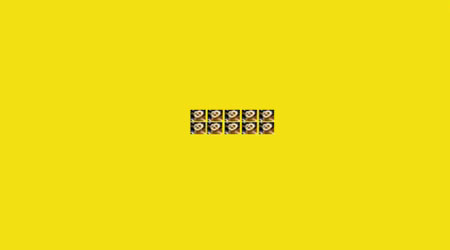
68.5% of the people live in cities or towns.

The birth rate in Bolivia is 22.4 births per 1,000 of population
The death rate in Bolivia is 6.5 deaths per 1,000 people.
Check this against the birth rate. If the death rate is higher than the birth rate then
the population will decrease unless immigrants arrive in the country.
There are 32.7 deaths of girls under 1 year per 1,000 of births and 39.9 deaths of boys.
The median age for females is 24.7 and for males is 24.3. The median age is that age which divides the population exactly in half so there are the same number
of people above the median age as below it.
The average age of a woman when she has her first child is 21.2.
The elderly dependency ratio is 10.6. This is the number of elderly people (ages 65+) per 100 people of working age (ages 15-64).
The potential support ratio is 9.4. This is the number of working-age people (ages 15-64) per one elderly person (ages 65+). As a population ages, the potential support ratio tends to fall, meaning there are fewer potential workers to support the elderly.
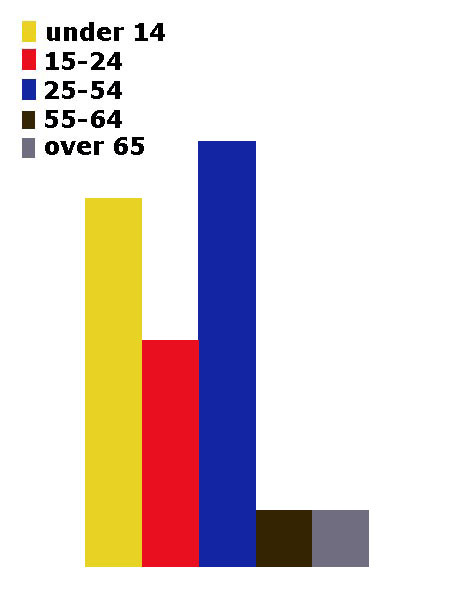
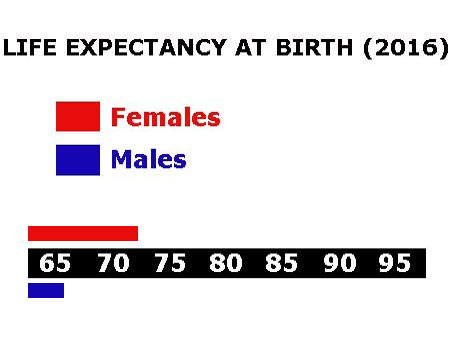

Bolivia spends 6.3% of its total income on health care.
There are 0.47 doctors per 1,000 people.
There are 1.1 hospital beds per 1,000 people.
20.2% of the population are estimated as obese.
96.7% of the urban population and 75.6% of the rural population have drinking water that is either piped into their home or they have access to a public tap, a protected borehole, well, spring or
protected rainwater collection facility.
60.8% of the urban population and 27.5% of the rural population have access to a flushing toilet that is connected to a sewer. a pit latrine (that is a
permanent hole in the ground that is looked after) or a composting toilet.
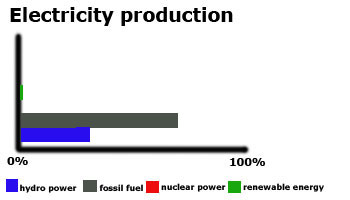
Bolivia releases 16.0 million metric tons of carbon dioxide by burning fossil fuels in the process of producing and consuming energy. This puts it as the 8th highest in South America.

Bolivia spends 7.3% of its total income on education.
Children usually start school at age 6 in Bolivia. Primary education is for eight years until age 14. In some areas children either attend in the morning or the afternoon.
Secondary education, which is not compulsory, can last till 18. This may be followed
by further education at a university or college.
Generally the school year consists of 2 terms and starts in the beginning of February and finishes at the end of November. There is usually a 2 week
break in July.
88.6% of femlaes and 96.5% of males are able to read and write by the age of 15.
6.9% of all people aged between 16 and 24 are not in work. Among females 8.6% are unemployed while with males 5.8% can't find work.
The total number of people available for work in Bolivia is 4.99 million.
 They work in the following sectors.
They work in the following sectors.
- Agriculture includes farming, fishing and forestry work
- Industry includes mining, manufacturing, construction and energy workers
- Services is everything else

There are 21 paved airports in Bolivia, which is the 8th highest number in South America.
![]()
There are 3,504 kilometres of railways in Bolivia, the 4th longest in South America.
![]()
There are 90,568 kilometres of roads in Bolivia, which means Bolivia is in 4th place for the most kilometres of roads in South America.
![]()
There are 6 major national newspapers in Bolivia.
There are 10.16 million mobile phone users.
8% of the people have a fixed landline.

4.87 million people have access to the internet at home via any device (computer or mobile).


